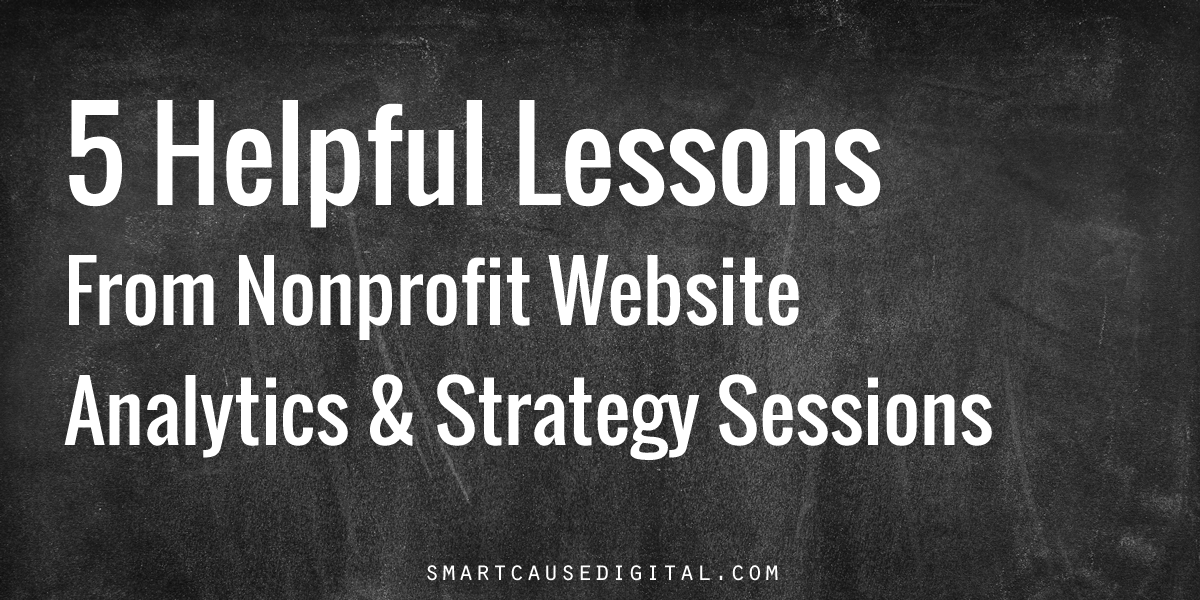July is one of my favorite months – along with January, April and October.
These are the months when I get together with each of my clients. We discuss their website goals, go through their analytics report, and find the unique opportunities that can help them get better results.
This month’s conversations have been especially interesting, and I want to share the most important lessons with you. I hope these lessons help *you* improve your website strategy and results!

1. When you’re serious about better results, you need Goals
As we approach mid-year, my clients who have configured Goals in Google Analytics are getting better results.
It makes sense. We can only improve what we measure.
You can use Goals to track website actions such as making a donation, signing up for email updates or registering for an event.
Then, here comes the nerdy part, you can dig down deep to understand where your donors/email subscribers/event attendees came from. Did they search a specific keyword? Were they already on your email list? Did they find you via social media?
Once you understand where your donors/email subscribers/event attendees, come from, you can invest your effort into those channels. It’s the smart way to get better results.
2. Campaigns are complicated, but always worth your effort
If you’ve ever taken one of my advanced Google Analytics trainings, then you’ve heard me say it over and over: Campaigns are the most powerful feature in Google Analytics.
Campaigns are also a pain in the butt to implement.
Campaigns are powerful because you can tailor them to fit your specific needs. That same ability to customize is what makes them difficult to implement.
If you haven’t implemented Campaigns yet, you’re not alone. My clients sometimes take months to fully set up their Campaigns.
But once they do, they *always* find useful insight that helps them improve their outreach.
3. Facebook can get people to your website, but good luck keeping them
Facebook is the leading source of social network traffic for most of my clients.
But visitors coming from Facebook also tend to spend less time on nonprofit websites than, say, visitors coming from Twitter.
So, while Facebook can help get people to your site, it’s up to you to find ways to keep them on your site.
4. Beware the custom content management system
If you’re building a new website anytime soon, I have one piece of advice for you: don’t choose a custom content management system.
When I run analytics reports for sites that run custom content management systems, I consistently see significant decreases in their search engine traffic.
Search engine visitors are an important source of new supporters, and a drop in search engine traffic is harmful to most nonprofit outreach programs.
5. Review your configuration regularly
Maybe someone set up Google Analytics for you back when you built your new site. Or perhaps you inherited the account and just assumed everything is configured correctly.
Your configuration probably needs an update.
Every new client I’ve started working with in 2017 had a Google Analytics configuration that needed a tweak. Some accounts weren’t configured to track downloads or links to external sites. Many accounts weren’t getting search query information.
Make sure you’re getting all the analytics information available to you by reviewing your configuration every 6 months or so.
Need help with Goals, Campaigns or Configuring Google Analytics?
I can help you in one of two ways. The best way to work with me is to join my Quarterly Website Strategy Sessions program. We’ll get together every three months and make sure that you’re using Goals and Campaigns to improve your results.
If you want to learn more about Google Analytics itself, check out my Google Analytics Toolkit training program. You can access all the training recordings immediately, and join me live when I teach the next session in the fall or spring.

